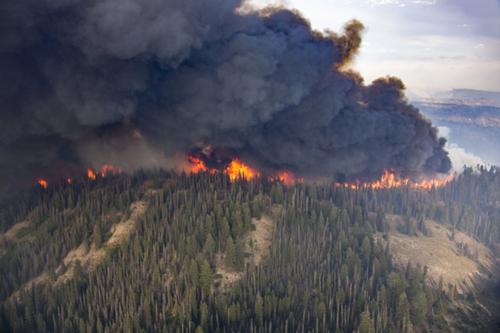当前位置:
X-MOL 学术
›
Hydrol. Process.
›
论文详情
Our official English website, www.x-mol.net, welcomes your
feedback! (Note: you will need to create a separate account there.)
Smoke deposition to water surfaces drives hydrochemical changes
Hydrological Processes ( IF 2.8 ) Pub Date : 2022-06-01 , DOI: 10.1002/hyp.14626 Elizabeth W. Boyer 1 , Max A. Moritz 2 , Michael G. Brown 3
Hydrological Processes ( IF 2.8 ) Pub Date : 2022-06-01 , DOI: 10.1002/hyp.14626 Elizabeth W. Boyer 1 , Max A. Moritz 2 , Michael G. Brown 3
Affiliation

|
This study presents a unique data set from a laboratory experiment where we explored changes in the chemical composition of deionized water samples exposed to smoke. Inside a laboratory hood, water samples placed into a chamber were exposed to smoke for up to 60 min. The pattern of variations in hydrochemistry observed over time with increasing smoke exposure was similar in response to two different smoke treatments generated from burning tree litter. To estimate the smoke dosage and assess the consistency of replicate smoke treatments, we conducted additional experiments to evaluate changes in light transmission. Smoke inputs to the deionized water samples drove changes in hydrochemistry, with increases in acidity (with decreasing pH values), the content of organic matter (with increasing concentrations of dissolved organic carbon and dissolved organic nitrogen), and the content of inorganic N species (with increasing concentrations of ammonium, nitrate, and nitrite). The study was conducted on deionized water samples, and the results may not be directly transferrable to natural waters. Stream or lake waters that are low in ionic strength, poorly buffered, or low in acid-neutralizing capacity might respond the most similar to the results of this study. In contrast, well-buffered surface waters having higher acid-neutralizing capacity would be more likely to neutralize acidic inputs from the smoke without significant effects on water quality. The publicly available dataset associated with this study will contribute to further consideration of the relative importance of short-term changes in hydrochemistry driven by in-stream inputs (e.g., changes in water chemistry from direct smoke deposition to the water surface) in contrast to terrestrial inputs (e.g., changes in water chemistry stemming from altered flow paths and source areas of the burned watershed landscape).
中文翻译:

烟雾沉积到水面驱动水化学变化
本研究提供了来自实验室实验的独特数据集,我们在该实验中探索了暴露于烟雾的去离子水样品的化学成分变化。在实验室通风橱内,将水样放入室内,暴露在烟雾中长达 60 分钟。随着时间的推移,随着烟雾暴露的增加,观察到的水化学变化模式与燃烧树屑产生的两种不同烟雾处理相似。为了估计烟雾剂量和评估重复烟雾处理的一致性,我们进行了额外的实验来评估光传输的变化。去离子水样品的烟雾输入推动了水化学的变化,随着酸度的增加(随着 pH 值的降低),有机物的含量(随着溶解的有机碳和溶解的有机氮的浓度增加)和无机氮的含量(随着铵、硝酸盐和亚硝酸盐的浓度增加)。该研究是在去离子水样品上进行的,结果可能无法直接转移到天然水体中。离子强度低、缓冲差或酸中和能力低的溪流或湖水可能与本研究的结果最相似。相比之下,具有较高酸中和能力的缓冲良好的地表水更有可能中和来自烟雾的酸性输入,而不会显着影响水质。
更新日期:2022-06-01
中文翻译:

烟雾沉积到水面驱动水化学变化
本研究提供了来自实验室实验的独特数据集,我们在该实验中探索了暴露于烟雾的去离子水样品的化学成分变化。在实验室通风橱内,将水样放入室内,暴露在烟雾中长达 60 分钟。随着时间的推移,随着烟雾暴露的增加,观察到的水化学变化模式与燃烧树屑产生的两种不同烟雾处理相似。为了估计烟雾剂量和评估重复烟雾处理的一致性,我们进行了额外的实验来评估光传输的变化。去离子水样品的烟雾输入推动了水化学的变化,随着酸度的增加(随着 pH 值的降低),有机物的含量(随着溶解的有机碳和溶解的有机氮的浓度增加)和无机氮的含量(随着铵、硝酸盐和亚硝酸盐的浓度增加)。该研究是在去离子水样品上进行的,结果可能无法直接转移到天然水体中。离子强度低、缓冲差或酸中和能力低的溪流或湖水可能与本研究的结果最相似。相比之下,具有较高酸中和能力的缓冲良好的地表水更有可能中和来自烟雾的酸性输入,而不会显着影响水质。











































 京公网安备 11010802027423号
京公网安备 11010802027423号